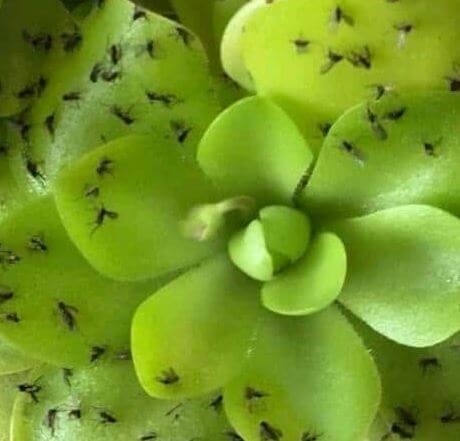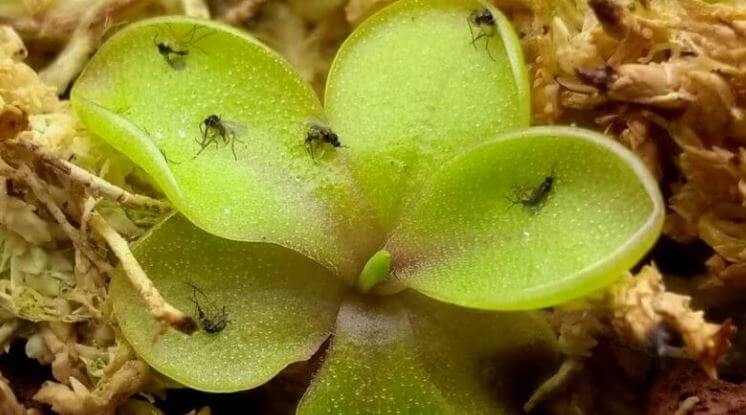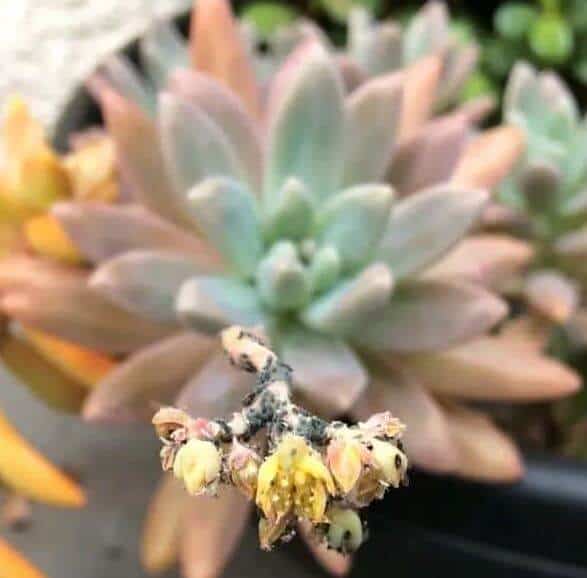Last Updated on July 12, 2023 by a Friendly Gardener
At some point, we all have encountered fungus gnats perhaps on a plant, near a drain, or when you open the compost bin. Gnats also referred to as fruit flies, thrive in places that are warm and humid, and despite their short lives, they proliferate rapidly meaning that infestations can last for some time. Succulents are no different than other houseplants when it comes to these pests. Fungus gnats on succulents require treatment to prevent eventual plant damage.
What Is a Fungus Gnat?

If you feed or water your houseplants, or even move them and a swirl of tiny flies surrounds you, you’ll know that fungus gnats have taken up residence in your indoor garden. These pesky annoying critters are minuscule flies that live in moist conditions and breed their next generation there. They love infesting potting soil or growing mediums as well as decomposing materials.
These pests are weak fliers and somewhat resemble mosquitoes but are smaller with long legs and antennae that appear longer than their heads. Six different gnat families belong to the fungus gnat group and include:
- Bolitophilidae
- Diadocidiidae
- Ditomyiidae
- Keroplatidae
- Mycetophilidae
- Sciaridae
The majority of these fungus gnats are not particularly damaging to plants, but the Sciaridae family contains several species that are. Larvae featuring transparent to white bodies and shiny black heads are usually a bit larger than adult gnats even reaching a quarter inch in length.
Fungus gnats have four stages in their brief life cycle:
- Egg
- Larvae
- Pupae
- Adult
As a prolific breeder, an adult fungus gnat can lay as many as 300 eggs during its brief life. Eggs are deposited on the soil surface especially when moist and rich.
Can Fungus Gnats Damage a Succulent?

Believe it or not, they can indeed, but you may not see the damage. Adult fungus gnats do not do much damage, but fungus gnat larvae are the true culprits. They are also difficult to contrast as they hide in the soil.
They feed on fungi and organic matter in the soil bed as well as plant roots including those of succulents. Gnat larvae chew holes in the succulent’s roots: This attack on the root system can cause wilts to yellow, wilt, and can be fatal if the infestation is severe. In heavily infested plants you may notice a shiny pathway on the soil surface. Succulent potting soil with too much moisture is a prime breeding ground.
The more dangerous species can also spread disease as their preferred meal is fungal spores. If they pick up dangerous spores from plants or soil beds that are infected, they can enable the spread of infection. They are known to be vectors of Fusarium wilt, Verticillium wilt, Botrytis blight, Pythium blight, and Black root rot.
How to Get Rid of Fungus Gnats on Succulents

To eradicate fungus gnats from your succulent, you’ll need to cover all your bases, or they will be back before you know it.
-
Hydrogen Peroxide
If you prefer to apply an organic solution you can use 3% hydrogen peroxide. Mix four parts of water with one part of hydrogen peroxide and drench the soil bed until the excess drains out of container drainage holes. Hydrogen peroxide will kill adult gnats and gnat larvae immediately.
-
Neem oil
For those that have neem oil on hand, this is another very effective organic solution for eliminating fungus gnats. Dilute the neem oil in water following the manufacturer’s indications and soak the soil bed right through to the bottom of the container allowing the excess solution to drain out. At the same time, spray the plant above the soil bed to contrast adult gnats that may be in the area.
-
Pyrethrin
Sprays made with pyrethrin are also effective in treating fungus gnats and their larvae. It is sufficient to spray a fine mist of the product on the soil surface and the plant itself. Spray soil beds to moisten the soil surface. Interrupt watering and allow the soil surface to dry to two inches in depth. Apply monthly until the fungus gnats disappear.
Environmental Prevention of Fungus Gnats

Overwatering creates the perfect environment for fungus gnat proliferation. Soggy soil is a favorite. Adjust your watering schedule to prevent a waterlogged growing medium and never leave your succulent standing in water such as a saucer or tray with standing water beneath the succulent’s pot.
Opt for a soil mix that has been formulated for succulents and cacti with excellent drainage and aeration. Use commercial compost that has been pasteurized to eliminate pest eggs and larvae. If you have a plant with fungus gnats, isolate it from other plants and succulents to prevent spreading the infestation.
When purchasing plants from nurseries or garden centers, examine the plant well. Examine succulent bases and the potting soil to verify if the surface exhibits whitish or transparent larvae featuring a black shiny head. Isolate new succulents for a while to verify if flies emerge.
Place raw potato trips or sticky yellow traps to capture adult fungus gnats. One adult can deposit up to 300 eggs, so keeping adults at bay is fundamental to prevent the laying of the eggs. You can also use a layer of mulch around the base of your succulent which covers the potting soil which will also inhibit egg laying.
In Conclusion

Fungus gnat larvae are harmful to succulents because they feed on the roots. Adults need to be eliminated because they lay hundreds of eggs. To rid your succulent of fungus gnats and their larvae, use hydrogen peroxide, neem oil, or a pyrethrin spray on soil bed surfaces and plants. Avoid overwatering and ensure proper drainage using a potting mix formulated for cacti and succulents.

